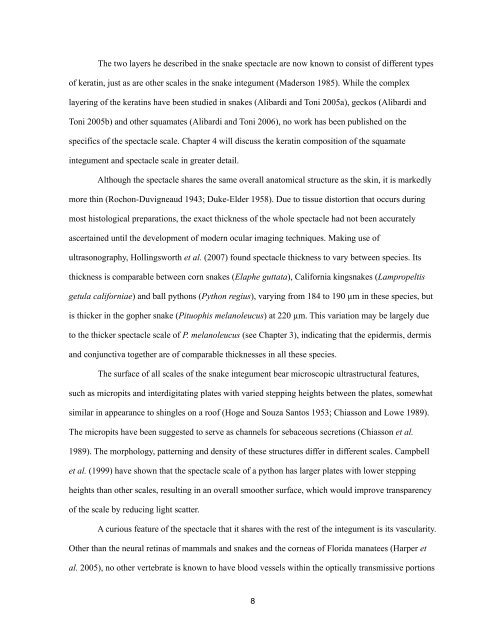Chapter 1, The Reptilian Spectacle - UWSpace - University of ...
Chapter 1, The Reptilian Spectacle - UWSpace - University of ...
Chapter 1, The Reptilian Spectacle - UWSpace - University of ...
Create successful ePaper yourself
Turn your PDF publications into a flip-book with our unique Google optimized e-Paper software.
<strong>The</strong> two layers he described in the snake spectacle are now known to consist <strong>of</strong> different types<br />
<strong>of</strong> keratin, just as are other scales in the snake integument (Maderson 1985). While the complex<br />
layering <strong>of</strong> the keratins have been studied in snakes (Alibardi and Toni 2005a), geckos (Alibardi and<br />
Toni 2005b) and other squamates (Alibardi and Toni 2006), no work has been published on the<br />
specifics <strong>of</strong> the spectacle scale. <strong>Chapter</strong> 4 will discuss the keratin composition <strong>of</strong> the squamate<br />
integument and spectacle scale in greater detail.<br />
Although the spectacle shares the same overall anatomical structure as the skin, it is markedly<br />
more thin (Rochon-Duvigneaud 1943; Duke-Elder 1958). Due to tissue distortion that occurs during<br />
most histological preparations, the exact thickness <strong>of</strong> the whole spectacle had not been accurately<br />
ascertained until the development <strong>of</strong> modern ocular imaging techniques. Making use <strong>of</strong><br />
ultrasonography, Hollingsworth et al. (2007) found spectacle thickness to vary between species. Its<br />
thickness is comparable between corn snakes (Elaphe guttata), California kingsnakes (Lampropeltis<br />
getula californiae) and ball pythons (Python regius), varying from 184 to 190 µm in these species, but<br />
is thicker in the gopher snake (Pituophis melanoleucus) at 220 µm. This variation may be largely due<br />
to the thicker spectacle scale <strong>of</strong> P. melanoleucus (see <strong>Chapter</strong> 3), indicating that the epidermis, dermis<br />
and conjunctiva together are <strong>of</strong> comparable thicknesses in all these species.<br />
<strong>The</strong> surface <strong>of</strong> all scales <strong>of</strong> the snake integument bear microscopic ultrastructural features,<br />
such as micropits and interdigitating plates with varied stepping heights between the plates, somewhat<br />
similar in appearance to shingles on a ro<strong>of</strong> (Hoge and Souza Santos 1953; Chiasson and Lowe 1989).<br />
<strong>The</strong> micropits have been suggested to serve as channels for sebaceous secretions (Chiasson et al.<br />
1989). <strong>The</strong> morphology, patterning and density <strong>of</strong> these structures differ in different scales. Campbell<br />
et al. (1999) have shown that the spectacle scale <strong>of</strong> a python has larger plates with lower stepping<br />
heights than other scales, resulting in an overall smoother surface, which would improve transparency<br />
<strong>of</strong> the scale by reducing light scatter.<br />
A curious feature <strong>of</strong> the spectacle that it shares with the rest <strong>of</strong> the integument is its vascularity.<br />
Other than the neural retinas <strong>of</strong> mammals and snakes and the corneas <strong>of</strong> Florida manatees (Harper et<br />
al. 2005), no other vertebrate is known to have blood vessels within the optically transmissive portions<br />
8
















